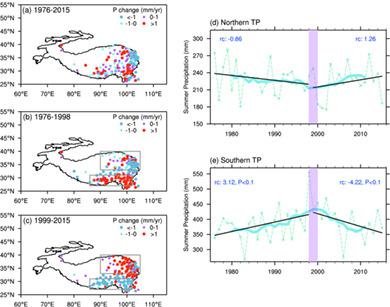当前位置:
X-MOL 学术
›
Int. J. Climatol.
›
论文详情
Our official English website, www.x-mol.net, welcomes your
feedback! (Note: you will need to create a separate account there.)
What induces the interdecadal shift of the dipole patterns of summer precipitation trends over the Tibetan Plateau?
International Journal of Climatology ( IF 3.5 ) Pub Date : 2021-04-01 , DOI: 10.1002/joc.7122 Yong Liu 1, 2 , Huopo Chen 1, 3 , Hua Li 3 , Guoqing Zhang 4 , Huijun Wang 1, 3
International Journal of Climatology ( IF 3.5 ) Pub Date : 2021-04-01 , DOI: 10.1002/joc.7122 Yong Liu 1, 2 , Huopo Chen 1, 3 , Hua Li 3 , Guoqing Zhang 4 , Huijun Wang 1, 3
Affiliation

|
Precipitation on the Tibetan Plateau (TP) exert great impacts on the energy, water cycle, and regional ecosystem. But due to the wide differences in climate regimes and complicated topography, TP precipitation is characterized as greater spatial diversity and lower confidence of temporal tendency. Based on the precipitation datasets from in situ observations, reanalysis, and satellites, this study identifies the interdecadal shift of the summer precipitation trends in the southern and northern TP, which corresponds well with the remarkable changes of TP lakes area in recent years. The statistical results indicate that the TP summer precipitation has experienced an interdecadal transition in the late 1990s, with precipitation increasing and then decreasing in the southern TP, and decreasing and then increasing in the northern TP. Further analyses suggest that the changes in moisture budget and convection activities play an important role in the interdecadal variations of precipitation in the northern and southern TP, respectively. More specifically, the variations in the southern TP are contributed largely by the persistent weakening sensible heat source, which can depress the ascending motion and hinder the northward moisture transport in the southern TP. While in the northern TP, both observations and model sensitivity experiments indicate that the co-effect of the cold interdecadal Pacific oscillation (IPO) and warm Atlantic multidecadal oscillation (AMO) has profound impacts on the decadal shift of the net moisture budget in the northern TP. Specifically, the AMO can impact the Lake Baikal anticyclone through the anomalous wave propagation and then decrease the moisture output in the eastern TP. While the IPO can weaken the climatological westerlies and prompt the moisture to get stuck in the northern TP. Consequently, the variations in the net moisture budget can give rise to the decadal variations in summer precipitation in the northern TP.
中文翻译:

是什么导致青藏高原夏季降水趋势偶极子格局的年代际偏移?
青藏高原降水对能源、水循环和区域生态系统产生重大影响。但由于气候状况差异大、地形复杂,青藏高原降水具有空间多样性大、时间趋势置信度低的特点。基于原位观测、再分析和卫星等降水资料,本研究确定了青藏高原南部和北部夏季降水趋势的年代际变化,与近年来青藏高原湖泊面积的显着变化非常吻合。统计结果表明,1990年代后期青藏高原夏季降水经历了年代际过渡,青藏高原南部降水先增加后减少,青藏高原北部降水减少后增加。进一步分析表明,水分收支和对流活动的变化分别对青藏高原北部和南部降水的年代际变化起重要作用。更具体地说,高原南部的变化主要是由持续减弱的感热源造成的,这会抑制上升运动,阻碍高原南部的水分向北输送。而在高原北部,观测和模式敏感性实验都表明,冷的年代际太平洋振荡(IPO)和温暖的大西洋年代际振荡(AMO)的共同作用对北部净水分收支的年代际变化产生了深远的影响。 TP。具体来说,AMO可以通过异常波传播影响贝加尔湖反气旋,从而降低高原东部的水分输出。而IPO可以削弱气候西风并促使水分滞留在高原北部。因此,净水分收支的变化会导致青藏高原北部夏季降水的年代际变化。
更新日期:2021-04-01
中文翻译:

是什么导致青藏高原夏季降水趋势偶极子格局的年代际偏移?
青藏高原降水对能源、水循环和区域生态系统产生重大影响。但由于气候状况差异大、地形复杂,青藏高原降水具有空间多样性大、时间趋势置信度低的特点。基于原位观测、再分析和卫星等降水资料,本研究确定了青藏高原南部和北部夏季降水趋势的年代际变化,与近年来青藏高原湖泊面积的显着变化非常吻合。统计结果表明,1990年代后期青藏高原夏季降水经历了年代际过渡,青藏高原南部降水先增加后减少,青藏高原北部降水减少后增加。进一步分析表明,水分收支和对流活动的变化分别对青藏高原北部和南部降水的年代际变化起重要作用。更具体地说,高原南部的变化主要是由持续减弱的感热源造成的,这会抑制上升运动,阻碍高原南部的水分向北输送。而在高原北部,观测和模式敏感性实验都表明,冷的年代际太平洋振荡(IPO)和温暖的大西洋年代际振荡(AMO)的共同作用对北部净水分收支的年代际变化产生了深远的影响。 TP。具体来说,AMO可以通过异常波传播影响贝加尔湖反气旋,从而降低高原东部的水分输出。而IPO可以削弱气候西风并促使水分滞留在高原北部。因此,净水分收支的变化会导致青藏高原北部夏季降水的年代际变化。











































 京公网安备 11010802027423号
京公网安备 11010802027423号